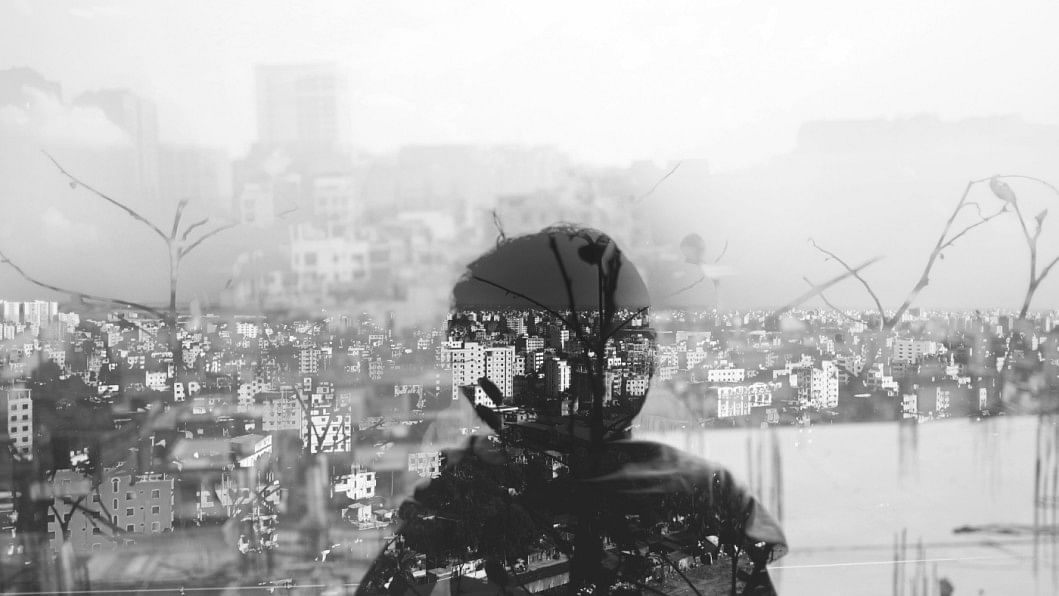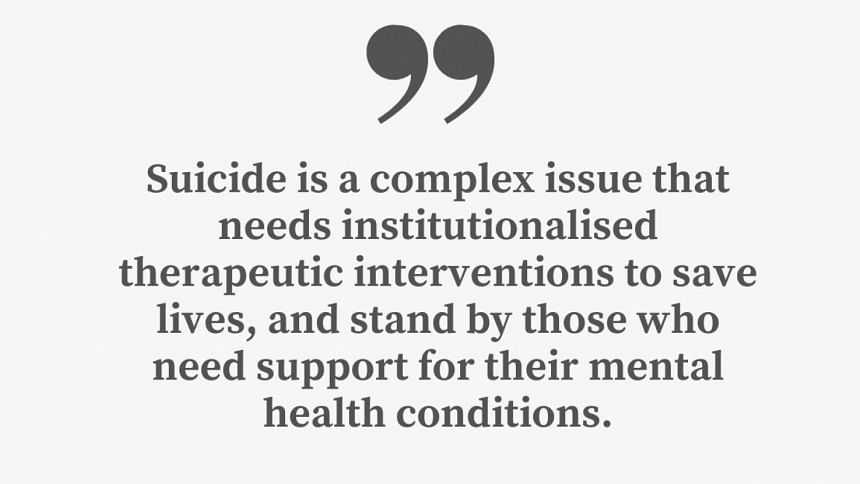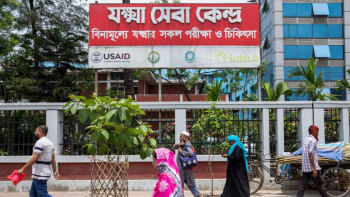Suicide prevention must embrace nuances and complexities

Every act of suicide carves a vacuum in which those left behind struggle to find meaning to this seemingly irrational action of ending one's life. The pointer of the blame goes in many directions. Those who are close to the victim engage in remorseful self-reflection to identify their share in the tragic event, or blame others to find comfort through a defence mechanism.
The legal provision to prove that someone is responsible for someone else's suicide can be tricky. The court needs to know if the defendant's action or inaction is the direct cause of the death. Did that person know, or should have known, that the dead individual had a suicidal tendency? What other factors could have instigated the suicide? What is the time gap between the act of suicide and the wrongful death action?
In Bangladesh, any news of suicide inevitably involves police arrests of some family members. Quizzing people close to the deceased to discern suspicious activities surrounding the death is a part of the police protocol. Unfortunately, I have seen how police use these unusual death cases for extortion and out-of-court settlements.
The media hype over suicide often prompts law enforcement agencies to engage in visible actions, ignoring the complicated nuances of suicide. Indeed, the family of a person that was forcefully or wrongfully led to suicide deserves justice or compensation. My concern, however, involves the broad-brush portrayal of suicide.
In June, a young man set himself on fire in front of the Press Club in protest of business fraud. He invested Tk 1.26 crore in a company believing that he would be made a partner. But after repeated attempts to get his share or his money back, he made a public statement by ending his life. The fraudsters are now being tried. This deliberate act of death is the ultimate resort of a desperate man who harmed himself to implicate the perpetrators. It is up to the court to decide whether the top bosses of the cosmetics company (in which the victim invested) are guilty of manslaughter or legally responsible for the death.
According to a survey report published earlier this year, as many as 101 students of different universities in Bangladesh died by suicide in 2021 against the backdrop of the Covid-19 pandemic. The figure, included in the survey that was conducted by a social organisation named Anchal Foundation, is strikingly higher than the pre-pandemic period. In 2017, 19 public and private university students died by suicide; in 2018, the toll stood at 11. At the height of the pandemic in 2020, 79 university students died by suicide. No data is available for 2019. Now, whom do we blame for these deaths for failing to provide psychosocial support to a frustrated generation? The list of causes cited by the report merits our attention: 24.75 percent of these students died by suicide over relationship issues, 19.8 percent due to family problems, 15.84 percent to end mental distress, 10.89 percent due to study-related issues, 4.95 percent due to financial issues, 1.98 percent of students died by suicide after becoming addicted to drugs, and 21.78 percent due to various other reasons.

The question is: How many intervention programmes have been undertaken to address this serious issue? As a top university administrator, I know of the two fully fledged programmes we ran to offer hotline services to our students during the pandemic. The number of students who needed help was staggering. For the sake of privacy, I cannot mention the figures here. All I can say is that we did manage to intervene in some critical cases.
Because of the stigma associated with mental health illness, parents often do not report related issues to the authorities of their children's educational institutions. Even when some of our students confess to their teachers about the parental pressure they feel at home, when contacted, the parents tend to be in denial to protect their wards from the supposed stigmatisation. Dealing with these cases made me realise that many of these deaths can be prevented, provided the involved parties learn to know and deal with the symptoms.
The parents who know that their children have a mental health condition must report it to the school authorities. If the students are on anti-depressants, that, too, needs to be reported as some of these drugs are allegedly responsible for inculcating suicidal thoughts in patients. Then again, the confidentiality of such reports should lie with designated counselling sections or professionals.
Each educational institute must have psychosocial counselling services or other peer support groups to address this issue. Without a proper channel to ventilate innermost anxiety, fear, frustrations, impulses, and desires, any individual with a mental health issue is prone to commit self-harm. Otherwise, we will simply associate the action with the immediate trigger or hearsay.
For instance, when a 14-year-old jumped off the roof of a 12-storey building in Shyamoli, we heard that she could not take the insult of failing higher mathematics at school. She was a top student in her class at Holy Cross School. She was allegedly flunked by her teacher as she did not seek private tuition. The truth will come out after the investigation, being carried out by both the police and the audit department of the education ministry, is completed. Do we know if the student was further humiliated at home for her exam performance?
The issue is greater than one death. It involves sensitivity to process the information, report the event, and judge the before and the after of the event. There seems to be a complete lack of understanding and empathy, except for the desire to be sensational. The circulation of the video footage of the suicidal jump captured by a nearby vendor is a case-in-point.
In 2017, Netflix streamed a controversial series titled 13 Reasons Why, in which a dead narrator shares her side of the story in a series of tapes to explain her decision. Each episode points to a particular reason (usually a person). While the series is blamed for glorifying suicide, it does warn us against oversimplifying suicide. It is a complex issue that requires professional interventions. We need institutionalised therapeutic interventions to save lives, and stand by those who need support for their mental health conditions. Our post-facto ahas and uhus mean little to those who have decided to end their lives.
Dr Shamsad Mortuza is the pro-vice-chancellor of the University of Liberal Arts, Bangladesh (ULAB).

 For all latest news, follow The Daily Star's Google News channel.
For all latest news, follow The Daily Star's Google News channel. 










Comments